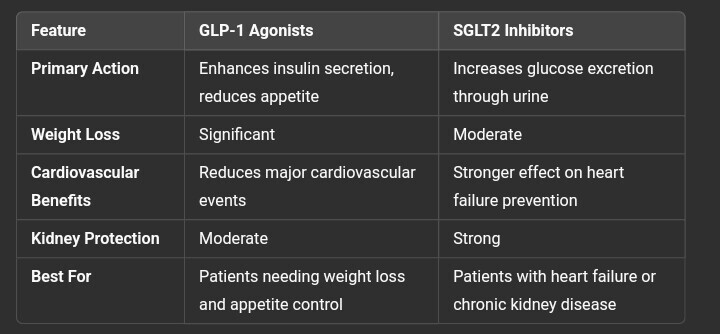
GLP-1 agonists are a groundbreaking class of medications revolutionizing diabetes and obesity management. These drugs mimic the natural hormone glucagon-like peptide-1 (GLP-1), which plays a crucial role in regulating blood sugar levels, promoting insulin secretion, delaying gastric emptying, and curbing appetite. By enhancing the body’s ability to manage glucose and weight, GLP-1 receptor agonists (GLP-1 RAs) have emerged as a preferred treatment option for individuals with type 2 diabetes and obesity.
How Do GLP-1 Agonists Work?
GLP-1 agonists function by binding to the GLP-1 receptor, stimulating insulin production only when blood sugar levels are elevated. This unique mechanism significantly reduces the risk of hypoglycemia, a common side effect associated with traditional diabetes medications. Furthermore, these drugs suppress glucagon release, which helps to stabilize blood glucose levels.
Several GLP-1 receptor agonists are currently available, including liraglutide, semaglutide, and dulaglutide. Each formulation has specific dosing guidelines and indications, but all share the fundamental objective of improving glycemic control and supporting weight management. Notably, semaglutide, under brand names like Ozempic and Wegovy, has gained popularity for its superior efficacy in weight loss and diabetes control.
GLP-1 Agonists vs. Other Diabetes Medications
A key reason GLP-1 agonists stand out from DPP-4 inhibitors and other diabetes treatments is their ability to promote significant weight loss. Unlike DPP-4 inhibitors, which work by preventing GLP-1 breakdown, GLP-1 agonists directly activate the GLP-1 receptor, resulting in more potent metabolic benefits. Additionally, GLP-1 RAs have demonstrated cardiovascular protective effects, reducing the risk of heart disease and stroke in people with type 2 diabetes.
The Link Between GLP-1 Agonists and Cancer Risk Reduction
Emerging research suggests that GLP-1 receptor agonists may play a role in cancer prevention. While diabetes itself is associated with an increased risk of certain cancers, including pancreatic, liver, and colorectal cancers, GLP-1 agonists have been studied for their potential protective effects. Some proposed mechanisms include:
* Improved Insulin Sensitivity: Chronic hyperinsulinemia is a known risk factor for cancer. By improving insulin sensitivity and reducing insulin levels, GLP-1 agonists may help mitigate cancer risk.
* Anti-Inflammatory Effects: Low-grade systemic inflammation is a hallmark of obesity and cancer. GLP-1 agonists have been shown to reduce inflammatory markers, potentially lowering cancer risk.
* Cellular Protection: Preclinical studies suggest that GLP-1 receptor activation may inhibit tumor cell proliferation and promote apoptosis (programmed cell death) in certain cancer types.
What Does the Research Say?
While more clinical trials are needed to establish a definitive link between GLP-1 agonists and cancer prevention, some observational studies have reported a lower incidence of certain cancers in individuals using these medications. However, concerns have been raised regarding the potential association between GLP-1 agonists and thyroid C-cell tumors, particularly in rodent studies. Human studies have not confirmed a significant risk, but ongoing monitoring and research are necessary to fully understand the long-term implications.
GLP-1 agonists offer more than just blood sugar control—they provide comprehensive metabolic benefits, including weight loss and cardiovascular protection. Their potential role in reducing cancer risk further underscores their importance in modern diabetes and obesity management. As research continues to unfold, these medications may become integral not only in treating metabolic disorders but also in preventive health strategies against certain cancers.
GLP-1 Agonists and Cancer Prevention: Investigating Potential Links

The relationship between GLP-1 receptor agonists (GLP-1 RAs) and cancer prevention is generating significant interest in the medical community. Researchers are actively exploring whether these drugs, commonly used to manage diabetes and obesity, could also contribute to reducing cancer risk. While definitive conclusions have yet to be reached, early investigations present intriguing possibilities.
Can GLP-1 Agonists Lower Cancer Risk?
GLP-1’s potential role in cancer prevention is still under scientific scrutiny. Some preliminary studies suggest that these medications may influence cell proliferation, potentially slowing tumor growth. However, these findings require more extensive research before any firm conclusions can be drawn.
One of the main hypotheses is that GLP-1 agonists may exert protective effects by:
– Regulating Insulin Levels: Chronic high insulin levels are linked to an increased risk of certain cancers. By improving insulin sensitivity and reducing hyperinsulinemia, GLP-1 RAs could indirectly lower cancer susceptibility.
– Reducing Inflammation: Persistent low-grade inflammation is a known contributor to cancer development. GLP-1 agonists have demonstrated anti-inflammatory effects, which may be beneficial in cancer risk reduction.
– Affecting Cell Growth Pathways: Some research suggests that GLP-1 activation may inhibit tumor cell proliferation and promote apoptosis (programmed cell death), though this remains an area of ongoing investigation.
What About Specific GLP-1 Agonists?
Ozempic (Semaglutide) and Cancer Risk Ozempic, one of the most well-known GLP-1 agonists, has been loosely associated with potential cancer risk reduction. However, current evidence remains inconclusive. While some observational studies hint at a possible protective effect, long-term clinical trials are needed to validate these claims and establish a clear link between semaglutide and cancer prevention.
Tirzepatide: A New Frontier in Research
Tirzepatide, a dual GLP-1 and GIP receptor agonist, has gained attention for its impressive metabolic benefits, including significant weight loss. However, its role in cancer prevention remains largely unexplored. Ongoing and future studies will determine whether its unique mechanism offers additional protective effects beyond glucose and weight management.
Considerations and Precautions
While GLP-1 agonists present exciting possibilities, they are not suitable for everyone. Individuals with a history of medullary thyroid carcinoma or multiple endocrine neoplasia syndrome type 2 (MEN2) are generally advised against using these medications due to potential thyroid tumor risks observed in animal studies. Although human data have not confirmed a direct link, caution remains paramount.
The potential cancer-preventive effects of GLP-1 agonists are still being explored, with promising but inconclusive findings. As ongoing research sheds more light on this subject, individuals considering these medications should stay informed and consult healthcare professionals to weigh the benefits and risks. Whether for diabetes management, weight loss, or possible cancer risk reduction, GLP-1 receptor agonists continue to reshape the landscape of metabolic health and disease prevention.
Cardiovascular Benefits of GLP-1 Agonists: A Closer Look
Cardiovascular disease (CVD) remains one of the leading causes of morbidity and mortality worldwide, posing a significant challenge in modern healthcare. Individuals with type 2 diabetes are at an even greater risk, as the condition often contributes to complications such as hypertension, atherosclerosis, and heart failure. In response to these challenges, glucagon-like peptide-1 receptor agonists (GLP-1 RAs) have emerged as a promising treatment not only for blood sugar control but also for cardiovascular protection.
How GLP-1 Agonists Benefit Heart Health
GLP-1 receptor agonists were originally developed for glycemic control, but ongoing research has revealed their significant cardiovascular benefits. The American Diabetes Association (ADA) and the European Society of Cardiology (ESC) now recognize GLP-1 agonists as a critical part of managing both diabetes and heart disease. The key cardiovascular benefits include:
– Reduced Risk of Major Cardiovascular Events (MACE): Clinical trials such as the LEADER (liraglutide) and SUSTAIN-6 (semaglutide) studies have demonstrated that GLP-1 agonists significantly lower the risk of heart attacks, strokes, and cardiovascular-related deaths.
– Improved Blood Pressure and Cholesterol Levels: GLP-1 agonists have been shown to modestly reduce systolic blood pressure and improve lipid profiles by lowering LDL cholesterol and increasing HDL cholesterol.
– Anti-Inflammatory and Anti-Atherosclerotic Effects: Chronic inflammation and plaque buildup in arteries are major contributors to cardiovascular disease. GLP-1 RAs help by reducing systemic inflammation and improving endothelial function, which may lower the risk of atherosclerosis.
– Weight Loss and Metabolic Improvements: Obesity is a major risk factor for CVD, and GLP-1 agonists such as semaglutide and liraglutide are particularly effective in promoting weight loss and reducing abdominal fat, leading to better heart health outcomes.
GLP-1 Agonists vs. SGLT2 Inhibitors for Cardiovascular Protection
When it comes to cardiovascular benefits, both GLP-1 receptor agonists and sodium-glucose co-transporter-2 (SGLT2) inhibitors play a crucial role. However, their mechanisms of action differ:
– GLP-1 Agonists: Primarily reduce atherosclerotic cardiovascular risk by addressing blood sugar, weight, and inflammation.
– SGLT2 Inhibitors: Focus more on heart failure prevention and kidney protection by promoting diuresis and reducing cardiac workload.
For patients at high risk of atherosclerotic cardiovascular disease (ASCVD), GLP-1 receptor agonists like semaglutide and liraglutide are often preferred due to their direct impact on reducing major cardiovascular events. Meanwhile, SGLT2 inhibitors are better suited for those with heart failure or chronic kidney disease (CKD). Many healthcare providers now consider dual therapy—combining GLP-1 agonists with SGLT2 inhibitors—to maximize cardiovascular protection.
Choosing the Right GLP-1 Agonist for Cardiovascular Benefits
Selecting the most appropriate GLP-1 receptor agonist depends on several factors, including cardiovascular history, weight loss goals, and patient tolerance. Here’s how some of the leading GLP-1 agonists compare:
– Semaglutide (Ozempic, Wegovy): Strong evidence for cardiovascular event reduction, significant weight loss benefits, and weekly dosing convenience.
– Liraglutide (Victoza, Saxenda): Well-documented heart health benefits, daily dosing, and effective glucose control.
– Dulaglutide (Trulicity): Demonstrated reduction in cardiovascular events, weekly dosing, and good tolerability.
For individuals with diabetes and established cardiovascular disease, semaglutide is often the preferred option due to its extensive clinical study profile and its documented ability to reduce the risk of stroke and heart attack.
The Future of GLP-1 Agonists in Cardiovascular Care
As research advances, the role of GLP-1 receptor agonists in cardiovascular disease management continues to expand. Emerging data is reinforcing their position as a cornerstone of cardiac metabolic treatment, offering benefits beyond glucose control.
New studies are exploring:
– Combination therapies with SGLT2 inhibitors and other cardioprotective agents.
– The potential of GLP-1 agonists in non-diabetic populations with high cardiovascular risk.
– Improved formulations for better patient adherence and convenience.
GLP-1 receptor agonists are transforming cardiovascular disease management by offering protection against heart attacks, strokes, and other cardiovascular complications. Their additional benefits in weight loss, inflammation reduction, and metabolic health make them a highly effective option for individuals with diabetes and heart disease.
With continuous research and clinical advancements, GLP-1 agonists are becoming a staple in personalized cardiometabolic treatment plans.
Patient-Centric Approach: Navigating Decisions on GLP-1 Agonist Use

Selecting the right medication is a deeply personal decision, influenced by an individual’s health goals, medical history, and lifestyle. GLP-1 receptor agonists (GLP-1 RAs) have emerged as a game-changing class of medications, offering benefits beyond glucose control, including weight management and cardiovascular protection. However, deciding whether these drugs are the right fit requires a thoughtful, patient-centered approach.
Who Can Benefit Most from GLP-1 Agonists?
GLP-1 agonists are primarily prescribed for individuals with type 2 diabetes, but their role extends beyond blood sugar regulation. These medications are increasingly considered for individuals who:
– Struggle with weight management and need an effective tool for sustained weight loss.
– Have an elevated cardiovascular risk, as certain GLP-1 RAs have been shown to reduce major cardiovascular events.
– Seek an alternative to insulin therapy, especially those concerned about hypoglycemia.
– Need comprehensive metabolic improvements, including reductions in inflammation and blood pressure.
Recognizing the most suitable candidates for GLP-1 therapy involves assessing not just diabetes status, but also broader health factors that influence long-term outcomes.
Balancing Benefits and Potential Risks
While GLP-1 agonists offer substantial health advantages, they are not without considerations. Patients must weigh the following benefits and potential drawbacks:
Key Benefits:
– Effective Blood Sugar Control: Helps lower A1C levels without causing frequent hypoglycemia.
– Significant Weight Loss: Many patients experience meaningful and sustained weight reduction.
– Cardiovascular Protection: Medications like semaglutide (Ozempic) and liraglutide (Victoza) have demonstrated cardiovascular benefits in clinical trials.
– Appetite Suppression: Helps regulate hunger signals, making it easier to maintain a healthy diet.
Potential Considerations:
– Gastrointestinal Side Effects: Nausea, vomiting, and diarrhea can occur, especially during the initial weeks of treatment.
– Injection Requirement: Most GLP-1 agonists require subcutaneous injections, which some patients may find inconvenient.
– Cost and Insurance Coverage: Depending on location and provider, access to GLP-1 RAs can be a financial consideration
– Thyroid and Pancreatic Concerns: While rare, these medications carry a warning for medullary thyroid carcinoma (MTC) and pancreatitis risk, making it crucial for patients to discuss family medical history with their healthcare provider.
GLP-1 Agonists vs. SGLT2 Inhibitors: Making the Right Choice
Both GLP-1 receptor agonists and SGLT2 inhibitors have demonstrated cardiovascular and metabolic benefits, but they work in different ways:

For individual focused on weight loss and glucose regulation, GLP-1 RAs may be the preferred option. Meanwhile, those at risk for heart failure or kidney disease may benefit more from SGLT2 inhibitors. In some cases, a combination approach using both drug classes may provide complementary benefits.
Importance of Shared Decision-Making
Choosing the right medication should involve open communication between the patient and healthcare provider. Key discussion points include:
– Personal Health Goals: Is weight loss a priority? Are there cardiovascular concerns?
– Lifestyle Considerations: Are injections manageable, or would a pill-based therapy be preferable?
– Financial and Insurance Factors: Will the medication be covered by insurance or require out-of-pocket costs?
– Medical History: Any personal or family history of thyroid cancer, pancreatitis, or kidney disease?
By addressing these factors, patients can make informed, confident decisions that align with their unique needs and preferences.
The Future of GLP-1 Agonists in Personalized Medicine
As research advances, GLP-1 receptor agonists are becoming a cornerstone in personalized metabolic care. Future innovations may bring oral formulations, Longer-acting versions, and even combination therapies that enhance efficacy while minimizing side effects. Additionally, studies are exploring their potential benefits beyond diabetes, such as in Alzheimer’s disease and fatty liver disease (NAFLD/NASH).
A patient-centric approach to GLP-1 agonist use prioritizes individual needs, ensuring that treatment decisions are tailored to specific health goals. While these medications provide remarkable benefits in blood sugar control, weight management, and heart health, choosing the right option requires thoughtful consideration and professional guidance.



